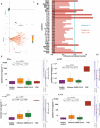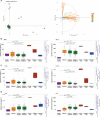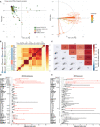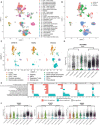Distinct inflammatory profiles distinguish COVID-19 from influenza with limited contributions from cytokine storm
- PMID: 33187979
- PMCID: PMC7725462
- DOI: 10.1126/sciadv.abe3024
Distinct inflammatory profiles distinguish COVID-19 from influenza with limited contributions from cytokine storm
Abstract
We pursued a study of immune responses in coronavirus disease 2019 (COVID-19) and influenza patients. Compared to patients with influenza, patients with COVID-19 exhibited largely equivalent lymphocyte counts, fewer monocytes, and lower surface human leukocyte antigen (HLA)-class II expression on selected monocyte populations. Furthermore, decreased HLA-DR on intermediate monocytes predicted severe COVID-19 disease. In contrast to prevailing assumptions, very few (7 of 168) patients with COVID-19 exhibited cytokine profiles indicative of cytokine storm syndrome. After controlling for multiple factors including age and sample time point, patients with COVID-19 exhibited lower cytokine levels than patients with influenza. Up-regulation of IL-6, G-CSF, IL-1RA, and MCP1 predicted death in patients with COVID-19 but were not statistically higher than patients with influenza. Single-cell transcriptional profiling revealed profound suppression of interferon signaling among patients with COVID-19. When considered across the spectrum of peripheral immune profiles, patients with COVID-19 are less inflamed than patients with influenza.
Copyright © 2020 The Authors, some rights reserved; exclusive licensee American Association for the Advancement of Science. No claim to original U.S. Government Works. Distributed under a Creative Commons Attribution License 4.0 (CC BY).
Figures





Update of
-
Targeted Immunosuppression Distinguishes COVID-19 from Influenza in Moderate and Severe Disease.medRxiv [Preprint]. 2020 May 30:2020.05.28.20115667. doi: 10.1101/2020.05.28.20115667. medRxiv. 2020. Update in: Sci Adv. 2020 Dec 9;6(50):eabe3024. doi: 10.1126/sciadv.abe3024. PMID: 32511543 Free PMC article. Updated. Preprint.
References
-
- Guan W.-J., Ni Z.-Y., Hu Y., Liang W.-H., Ou C.-Q., He J.-X., Liu L., Shan H., Lei C.-L., Hui D. S. C., Du B., Li L.-J., Zeng G., Yuen K.-Y., Chen R.-C., Tang C.-L., Wang T., Chen P.-Y., Xiang J., Li S.-Y., Wang J.-L., Liang Z.-J., Peng Y.-X., Wei L., Liu Y., Hu Y.-H., Peng P., Wang J.-M., Liu J.-Y., Chen Z., Li G., Zheng Z.-J., Qiu S.-Q., Luo J., Ye C.-J., Zhu S.-Y., Zhong N.-S.; China Medical Treatment Expert Group for Covid-19 , Clinical characteristics of Coronavirus Disease 2019 in China. N. Engl. J. Med. 382, 1708–1720 (2020). - PMC - PubMed
-
- Huang C., Wang Y., Li X., Ren L., Zhao J., Hu Y., Zhang L., Fan G., Xu J., Gu X., Cheng Z., Yu T., Xia J., Wei Y., Wu W., Xie X., Yin W., Li H., Liu M., Xiao Y., Gao H., Guo L., Xie J., Wang G., Jiang R., Gao Z., Jin Q., Wang J., Cao B., Clinical features of patients infected with 2019 novel coronavirus in Wuhan, China. Lancet 395, 497–506 (2020). - PMC - PubMed
-
- Grasselli G., Zangrillo A., Zanella A., Antonelli M., Cabrini L., Castelli A., Cereda D., Coluccello A., Foti G., Fumagalli R., Iotti G., Latronico N., Lorini L., Merler S., Natalini G., Piatti A., Ranieri M. V., Scandroglio A. M., Storti E., Cecconi M., Pesenti A.; COVID-19 Lombardy ICU Network , Baseline characteristics and outcomes of 1591 patients infected with SARS-CoV-2 admitted to ICUs of the Lombardy Region, Italy. JAMA 323, 1574–1581 (2020). - PMC - PubMed
-
- Bhatraju P. K., Ghassemieh B. J., Nichols M., Kim R., Jerome K. R., Nalla A. K., Greninger A. L., Pipavath S., Wurfel M. M., Evans L., Kritek P. A., West T. E., Luks A., Gerbino A., Dale C. R., Goldman J. D., O’Mahony S., Mikacenic C., Covid-19 in critically ill patients in the Seattle Region - Case series. N. Engl. J. Med. 382, 2012–2022 (2020). - PMC - PubMed
Publication types
MeSH terms
Substances
Grants and funding
LinkOut - more resources
Full Text Sources
Medical
Research Materials

